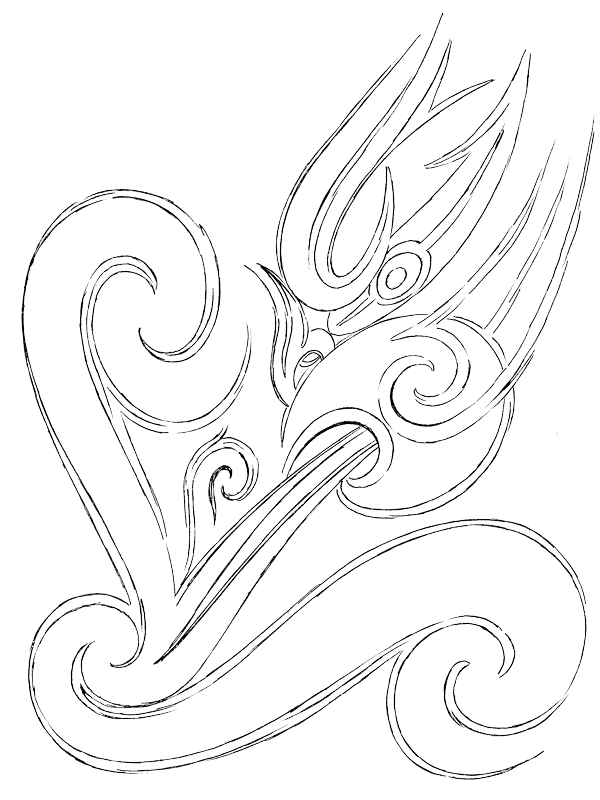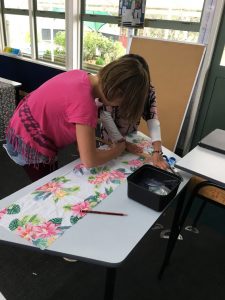
Tawhirimātea represents qualities of the wind; changeable, gentle, fresh, brisk, and stormy.
The kids at Canvastown School have been fully absorbed in discovering what creatures live in the school’s wild places and reflecting how their actions connect them back to Papatūānuku…
They have poked under logs and in tree-stumps, crawled through long grass, shaken the branches of trees and picked through the edible gardens, seeking out all manner of living things.
 Canvastown students used the Living Landscapes Theme Area from the Enviroschools Kit to take a closer look at the birds, bugs, plants and fungi, finding names for them all and learning about their interesting habits.
Canvastown students used the Living Landscapes Theme Area from the Enviroschools Kit to take a closer look at the birds, bugs, plants and fungi, finding names for them all and learning about their interesting habits.
Enviroschools Facilitator Angela Wentworth visited and helped the students engage in the activities from Tiro One One – our Marlborough living landscapes resource.
The school also received a visit from Wendy from DOC, who spoke to the students about the different predators in our forests. She helped the students to set up tracking tunnels so they could see if they had any of these predator animals at their school.
The tracking tunnels have a long white piece of cardboard inside them, and a dab of peanut butter to tempt the pests to visit. A patch of black ink in the middle of the cardboard means that any visitors leave their foot or body prints on the white cardboard, and the students can then use these prints to figure out which creatures have been through.

I was the peanut butter boy when we set the tracking tunnels. I had to dig my finger in and put a blob of peanut butter on the leaf. – Josh
We wrote down where all the tracking tunnels were around the school and we found mouse prints on some of them and something has bitten them! – Leah
I found poo under the tree and it looked like possum or wild cat poo. We could set cage traps to catch them! – Luke

The students found mouse prints in one of their tracking tunnels, which led into some inquiry learning around trapping. They researched traps used by indigenous people around the world and then came up with their own trap designs, making their own traps and trying them out for real.
“The idea for the trapping project came as a response to a need to engage a group of boys with their learning… It is also a really good process for students to examine their play environment with a different set of eyes and gain more sense of kaitiakitanga for their special areas outside”. – Kate Bowes, Enviroschools Lead Teacher.
The students were able to engage their inquiry learning further as they were then lucky enough to travel into Queen Charlotte Sounds for their school camp, which focussed on historical and ecological concepts through a Māori world view. “It was great for our kids who are avid hunter and gathers to discuss ideas around marine reserves and fishing restrictions”, said lead teacher Kate Bowes. “Our visit to Motuara Island topped it all off as the students could witness first hand the bird life we can expect in an area which is pest free”. The students were able to hear the birds, be in the bush and hear tales of the past from a Māori perspective from tour leaders Peter and Takutai Beech.
As they develop their sense of their own place in these local spaces, there are other real benefits to the connections and links that students have been making. They have had some real ‘light-bulb’ moments in discovering how the river that runs past their school is connected to the Pelorus River, which in turn connects with the Pelorus Sound, and how the various rivers near their homes link with each other and the sea. As they piece together the puzzle of their local landforms and waterways, they are forming their own connections with these places, developing their sense of whenuatanga.
Recognising that all areas of their school are connected too, students have also been taking a careful look at waste in their school and have discovered that some of the school’s tiniest residents have been working hard under some difficult conditions. A peek inside the worm farm found that while the worms do a great job of recycling food scraps from lunchboxes and turning it into lovely soil and natural fertiliser, they were in need of some help from students and staff.

Making wraps.
The students took action, starting up a new worm farm that had been donated to the school, and giving the existing one a helping hand. The students with horses brought in some manure to get the worms started, and they gave their collection roster and worm buckets a revamp. They made new signs showing what scraps the worms like and don’t like, and they communicated with the school about how to keep the worms happy and productive.
Students have also learnt to make beeswax wraps, becoming expert in the process and making loads of wraps so the school community can enjoy litter-free morning teas and lunches. They are also selling these as an ongoing fundraiser for school camp in Term 4.
These projects have enhanced the value of subsequent activities, both at school and in the Canvastown community. For example, Canvastown students now understand why it is important to plant trees because they know what ecosystems they can find living in planted areas in the years to come. When the children venture out into wild spaces beyond school (e.g. Maud Island camp), they have a good foundation of knowledge about endangered species and why we need to work to help them.
As Canvastown School begin the next steps in their journey to make their school more of a haven for native birds, bugs and lizards, their is no doubt their understanding of kaitiakitanga will continue to grow and become embedded throughout the school.
